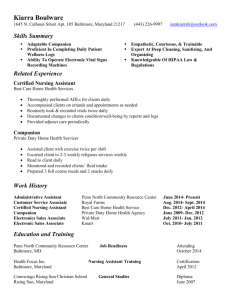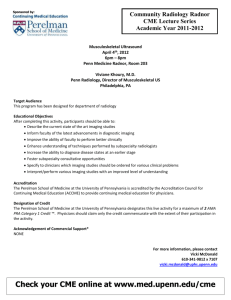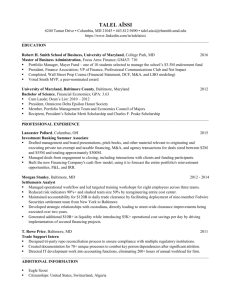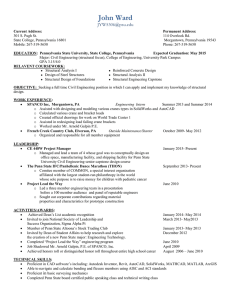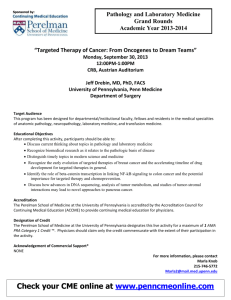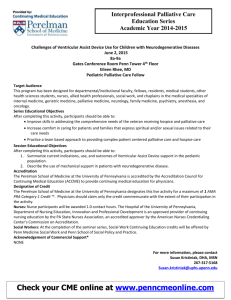Complications
advertisement
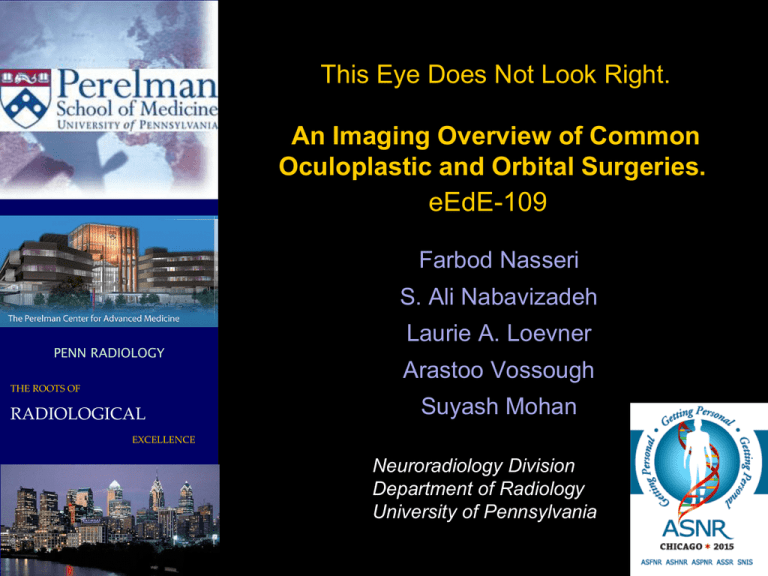
This Eye Does Not Look Right. An Imaging Overview of Common Oculoplastic and Orbital Surgeries. eEdE-109 Farbod Nasseri S. Ali Nabavizadeh PENN RADIOLOGY Laurie A. Loevner Arastoo Vossough THE ROOTS OF RADIOLOGICAL Suyash Mohan EXCELLENCE Neuroradiology Division Department of Radiology University of Pennsylvania Disclosure statement • Neither the authors nor their immediate family members have a financial relationship with a commercial organization that may have a direct or indirect interest in the content. Baltimore, Maryland Perelman School of Medicine at University of Pennsylvania Penn Radiology Purpose • To present a comprehensive and systematic review of the imaging spectrum of the oculoplastic and orbital surgeries including various types of orbital implants and prostheses. • To review imaging features of potential surgical complications and discuss plausible pitfalls. Baltimore, Maryland Perelman School of Medicine at University of Pennsylvania Penn Radiology Approach • Orbital surgeries Reconstruction, augmentation, decompression Enucleation, evisceration, exenteration • Lacrimal apparatus surgery • Lens surgery & implants • Eyelid surgery • Strabismus surgery • Glaucoma surgery • Retinopexy & scleral buckles • Intraocular injection Baltimore, Maryland Perelman School of Medicine at University of Pennsylvania Penn Radiology Discussion • The development of new surgical techniques, as well as advances in the prostheses offer a wide range of novel alternatives for orbital and oculoplastic surgeries. • Imaging plays a critical role in the postoperative setting, enabling early diagnosis of complications as well as long term follow-up evaluation. • A comprehensive pictorial review of postoperative orbit will be presented. Baltimore, Maryland Perelman School of Medicine at University of Pennsylvania Penn Radiology Orbital wall reconstruction/augmentation Titanium Traditional Silicone Autologous cartilage or bone Implant material New Porous polyethylene Pros Cons Porous polyethylene Allow vascularization Improved biocompatibility No need for fixation Infection Titanium Accurate contour Large defect Cost Needs fixation Imaging: To assess for complications: • Foreign body reaction (allograft implant) • Infection • Extrusion, deformity, subsiding • Rectus muscles impingement, optic nerve compression • Lacrimal sac obstruction Baltimore, Maryland Perelman School of Medicine at University of Pennsylvania Penn Radiology 6 Y/F with fibrous dysplasia & left optic nerve compression symptoms treated with frontal orbital advancement & reconstruction of the left orbital roof Coronal CT * Coronal T1 MR 3-D volume rendered CT * Extensive involvement of left calvarium with fibrous dysplasia causing narrowing of left orbital apex & left eye proptosis. Orbital decompression and orbital roof reconstruction using bone grafts. Coronal CT Baltimore, Maryland Perelman School of Medicine at University of Pennsylvania Postop 3-month follow-up Penn Radiology 53 Y/M with facial & orbital floor (blow-in) fractures after falling off skateboard Pre op Coronal CT Multiple facial bone fractures including the inferior wall of the left orbit. Small displaced bone fragment in left orbit. Post op Coronal CT Post op 3-D volume rendered CT Reconstruction of the inferior wall of the left orbit with a metallic mesh. Fixation of left lateral orbit & inferior orbital rim using screws/plates. Baltimore, Maryland Perelman School of Medicine at University of Pennsylvania Penn Radiology 53 Y/M with sinonasal undifferentiated carcinoma (SNUC) of right maxilla & orbit, status post right maxillectomy & exenteration followed by left radial forearm free flap reconstruction 2 years later Pre op Heterogeneously mass within the right maxillary sinus with extension into the right nasal cavity & into right orbital floor, abutting the right inferior rectus muscle Post op Coronal T1 Axial T1 Coronal T1 Baltimore, Maryland Perelman School of Medicine at University of Pennsylvania Post op Coronal Axial T1 T1 3-D volume rendered CT Orbital exenteration, maxillectomy reconstruction using metallic mesh, sphenoidotomy & ethmoidectomy. Radial forearm free flap reconstruction Penn Radiology Orbital Decompression • Indication: Thyroid-related immune orbitopathy (TRIO) Proptosis and intraocular pressure. Improve Visual acuity • Techniques: resection of the medial, lateral, or inferior orbital walls • Imaging: • Bulging enlarged orbital fat and rectus muscles through these defects. • Resection of portion of paranasal sinuses. • Complications: globe displacement diplopia, CSF leak, optic neuropathy, orbital cellulitis, excess herniation of orbital contents sinus obstruction. Baltimore, Maryland Perelman School of Medicine at University of Pennsylvania Penn Radiology 71 Y/F with thyrotoxic exophthalmos & compressive optic neuropathy Enlargement of bilateral extraocular muscles. Coronal CT Coronal T1 Coronal T1 Baltimore, Maryland Perelman School of Medicine at University of Pennsylvania Bilateral orbital decompression with defects of the medial orbital walls. Continued enlargement of the extraocular muscles. Decreased crowding at the orbital apices (left more than right) with mild medial deviation left optic nerve. Penn Radiology Orbital Enucleation / Evisceration Evisceration: removal of globe contents, preserving the sclera & extraocular muscles. Enucleation: removal of globe contents entirely, preserving the extraocular muscles. Intraocular malignancies Indication Irreparable globe rupture Prevention of sympathetic ophthalmia Globe implants: provide orbital volume for cosmesis following enucleation. Cover shell / eye prosthesis (anterior) Implant Components Orbital implant (posterior) Materials: metallic (old), hydroxyapatite, solid silicone, & Medpor (new). www.oasa.org.za Pitfall: Diffuse linear enhancement surrounding the implant (no clinical significance). Complications: rotation, infection, inflammation, & exposure. Baltimore, Maryland Perelman School of Medicine at University of Pennsylvania Penn Radiology 76 Y/F with history of right supraorbital/ frontal scalp squamous cell carcinoma status post Mohs surgery T2 & enhanced T1 images show right supraorbital & frontal scalp tumor with perineural spread along supraorbital nerve. Coronal T2 Coronal T1 post Postop: right eye evisceration. Axial CT Baltimore, Maryland Perelman School of Medicine at University of Pennsylvania Penn Radiology Orbital Exenteration Primary orbital malignancies Indication Orbital invasion by periorbital malignancies Subtotal: sparing of the eyelid Exenteration types Total (extended): removal of eyelid + orbit Radical: removal orbit + periorbial structures • Complications: fistulae, necrosis, dehiscence, infection. Baltimore, Maryland Perelman School of Medicine at University of Pennsylvania Penn Radiology 56 Y/F with right sinonasal melanoma treated with orbital exenteration * * * Melanoma filling the nasal cavity, ethmoid air cells, extending into the maxillary, frontal, and sphenoid sinuses, with intraorbital extension to the medial extraconal fat, and the trochlea, medial rectus, and inferior muscle complex, involving the planum sphenoidale, and mild dural extension. Complicated with bilateral subdural effusions. Orbital exenteration & myocutaneous free flap reconstruction extending into the right maxillary sinus, nasal cavities & ethmoid air cells. Baltimore, Maryland Perelman School of Medicine at University of Pennsylvania Penn Radiology 25/M with gunshot wound, extensive post-traumatic changes presented with an orbital mass. * Axial CT Left globe prosthesis. Patient developed extra-osseous mucocele postoperatively in the region of the left superior orbital rim. Notice: Right globe is absent. Baltimore, Maryland Perelman School of Medicine at University of Pennsylvania * Axial CT Extra-osseous enlarging mucocele on 3-month follow-up. Left globe prosthesis. Penn Radiology Lacrimal apparatus surgery Dacryocystorhinostomy Relieve lacrimal obstruction Nasolacrimal duct stents or Jones tubes Dacryocystorhinostomy (Preferred treatment) • Remove bone from medial canthus connect nasolacrimal duct with nasal cavity. • External • Endonasal • Complications: Restenosis Nasolacrimal duct stents / Jones tubes: • Composed of metalor plastic. Tubular structure + “mushroom” component • Complications: stent malposition or migration, inflammation, pneumorbit • Poor long-term patency • Up to 65 % of stents become occluded by granulation tissue or mucoid debris Baltimore, Maryland Perelman School of Medicine at University of Pennsylvania Penn Radiology 60 Y/M with right lacrimal sac carcinoma s/p right maxillectomy with reconstruction, presents with epiphora Sequential Coronal CT Coronal T2 MR Right dacryocystorhinostomy with stent placement, extending into the nasal cavity Baltimore, Maryland Perelman School of Medicine at University of Pennsylvania Penn Radiology Lens surgery and implants • Optic Cataracts are common causes of vision loss Intraocular lens implant: Replacement after lens extraction Intraocular lens implants Optic (clear lens) Haptics (stabilizing arms) Haptics www.nature.com/eye/journal • Imaging: Lens prostheses are very thin structures in profile. • Optic: radiodense on CT , low signal intensity on both T1 & T2 MRI. • Haptic: may not visible at 1.5 T MRI or on thin-section CT. • Intraocular lens prostheses do not normally enhance. • Complications: retained lens fragments, displacement, dislocation, calcifications. Lensectomy: • Resection of the crystalline lens (transscleral retrociliary incision). • Mainly for treatment of pediatric cataracts. • Imaging: no apparent separation between the anterior chamber and the globe. Baltimore, Maryland Perelman School of Medicine at University of Pennsylvania Penn Radiology Intraocular lens implant Right prosthetic lens implant: optic and haptics. Native left lens. Axial T1 Dystrophic calcification on the surface of the right intraocular lens implant. Axial T1 Baltimore, Maryland Perelman School of Medicine at University of Pennsylvania Penn Radiology Eyelid surgery Eyelid Weights • Indication: Facial nerve deficits lagophthalmos keratitis • Implanted subcutaneously in the upper eyelid • Secured to the tarsus enabling eye closure • Gold eyelid weights: MRI compatible • >90 % improved visual acuity • Complications: • Infection, allergic reaction, migration, & extrusion The patient has a history of left facial nerve palsy. A left upper eyelid weight which causes streak artifacts on CT & susceptibility artifact on MRI. Coronal CT Axial CT Axial T2 Baltimore, Maryland Perelman School of Medicine at University of Pennsylvania Penn Radiology Eyelid surgery Blepharoplasty • Surgical reconstruction of the eyelids. • Indications: ptosis, thyroid orbitopathy, and facial cosmesis. Sling blepharoplasty: suspend the eyelid to the frontal bone. Blepharoplasty techniques Augmentation blepharoplasty: using implants or tissue repositioning. Reduction blepharoplasty: removal of excess tissue. • • Imaging: • Often no appreciable imaging correlate • Some materials used for augmentation can be seen • Sling blepharoplasty anchors Complications: • eyelid malposition, strabismus, scarring, & persistent edema Baltimore, Maryland Perelman School of Medicine at University of Pennsylvania Penn Radiology Strabismus surgery Diplopia (nerve palsy) Reduced binocularity Indications Constricted visual field secondary to strabismus Abnormal head position secondary to ocular misalignment • Repositioning portions of the rectus muscle bellies onto the sclera Changes in size and morphology of the rectus muscles Imaging Improved ocular alignment Evaluating postoperative complication • Complications: rectus muscle rupture/slippage, infection Baltimore, Maryland Perelman School of Medicine at University of Pennsylvania Penn Radiology Pre op 6 m/F with Axenfeld Rieger syndrome presented with congenital hypoplastic lateral rectus muscles Post op The globes are rotated internally. The lateral rectus muscles are hypoplastic. Status post right strabismus surgery, involving transposition of superior and inferior rectus laterally. Resolution of internal rotation of the globes. New right hypertropia and dissociated vertical deviation due to unbalanced transposition (slight overcorrection). Baltimore, Maryland Perelman School of Medicine at University of Pennsylvania Penn Radiology Glaucoma surgery • Purpose: to reduce intraocular pressure by decompression of aqueous humor Non-valved: Molteno, Baerveldt. Types of shunt implants Valved: Ahmed, Krupin. Valve Valve shunt Plate: implanted underneath the conjunctiva Tube: inserted into the anterior chamber www. sanantonioeyeinstitute.com • Bleb (Reservoir): A fibrous capsule forms around the aqueous humor • Glaucoma valve implants are MRI compatible • Low signal on both T1- and T2-WI surrounded by a small amount of fluid in the reservoir • Complications: malposition, obstruction, giant bleb formation, infection, choroidal detachment Baltimore, Maryland Perelman School of Medicine at University of Pennsylvania Penn Radiology 2 Y/F with Sturge-Weber syndrome and a glaucoma shunt Sagittal T1 www. sanantonioeyeinstitute.com/ glaucoma-tube-shunts/ Coronal T2 Sagittal CT Left Ahmed shunt valve supralateral to the left optic globe shows linear low signal on T1 and T2 images & linear hyperdensity on CT which is surrounded by fluid (blebs). Baltimore, Maryland Perelman School of Medicine at University of Pennsylvania Penn Radiology 2 Y/F with Sturge-Weber syndrome and bilateral glaucoma s/p bilateral Ahmed valved shunts Coronal T2 Coronal & axial T2 images show bilateral linear low signal Ahmed valved shunts surrounded by fluid blebs. Larger amount fluid on the left which indents the globe. Out-pouching of fluid signal within the left orbit, anterior to the valve. Axial T2 Coronal T2 Baltimore, Maryland Perelman School of Medicine at University of Pennsylvania Penn Radiology Retinopexy & scleral buckles • Scleral buckles or bands: circular devices positioned around the globe for treatment of retinal detachment. The buckles exert pressure to appose the layers of the retina together. Hydrophilic hydrogel polymers (fluid density) Composition Silicone Solid rubber bands (high density) Sponges (air density) http://www.webmd.com/ scleral-buckling-surgery-postoperative • Complications: infection, scleral invasion & extrusion • Hydrogel implants: less stiff (less scleral erosion), can swell (permeable to water). Pitfall: mimic orbital mass or infection. Surgical history, tubular configuration of the implant encircling the globe & lack of restricted diffusion helps in differentiating from infection. Baltimore, Maryland Perelman School of Medicine at University of Pennsylvania Penn Radiology 85 Y/F with history of retinal detachment, s/p scleral buckle retinopexy Axial CT http://vissioneyes.com/ retinal-detachment-treatment.html High-density scleral buckles surrounding the right globe. Pitfall: Scleral buckles may mimic senile calcifications, hemorrhage, or masses. Axial CT Senile calcifications Baltimore, Maryland Perelman School of Medicine at University of Pennsylvania Penn Radiology 48 Y/M with retinal detachement s/p rubber band silicon retinopexy The scleral band are low signal intensity on T1 & T2 MR. Axial T2 Mild indentation on the globe is an expected finding & should not considered abnormal. Axial T1 Coronal T2 Baltimore, Maryland Perelman School of Medicine at University of Pennsylvania Penn Radiology Intraocular injections Indication: To tamponade the retina following retinal detachment until chorioretinal adhesions form. Pneumatic Retinopexy (Intraocular gas injection): (Effective up to 80 %) • To restore intraocular volume during scleral banding • A variety of gases: air, hexafluoride, & perfluoropropane • Imaging: Air lucency is present antidependently in the vitreous body, creating an air-fluid level • Complications: secondary glaucoma, gas migration, vitreous hemorrhage, endophthalmitis & proliferative vitreoretinopathy Intraocular Silicone Injection: • The silicone oil used for tamponade is usually removed after 8 weeks, but may remain permanently, depending on the risk of recurrent detachment • Imaging: On CT, silicone oil is hyperdense & globular, measuring up to 120 HU • Complications: choroidal detachment, scarring, cataracts, & optic nerve atrophy Baltimore, Maryland Perelman School of Medicine at University of Pennsylvania Penn Radiology 58 Y/M with history of retinal detachment following pneumatic retinopexy Intraocular air is seen as non dependent hypointensity on T1 & T2 images within the vitreous. Axial T1 It creates an air-fluid level left orbit. Pitfall: Pneumatic retinopexy can mimic orbital abscess & post traumatic orbital emphysema. Axial T2 Sagittal T2 Baltimore, Maryland Perelman School of Medicine at University of Pennsylvania Penn Radiology 36 Y/M with traumatic brain injury & retinal detachment. Intraocular silicone injection for retinopexy. Axial CT Bilateral globular hyperdense silicon in the globes Pitfall: Silicon can mimic blood, but blood typically layers dependently & is not as dense as the silicone. The intraocular silicone is isointense to muscle & hyperintense to fluid on T1 while hypointense on T2. Axial T1 Chemical shift artifact, at the interface between the silicone and the vitreous, can distinguish the silicon from blood. Axial T2 Baltimore, Maryland Perelman School of Medicine at University of Pennsylvania Fat saturation pulses can also help distinguishing the two by causing some degree of signal suppression. Penn Radiology Conclusion Familiarity with imaging findings of the wide-ranging spectrum of postoperative changes are crucial to differentiate expected postoperative findings from complications. Baltimore, Maryland Perelman School of Medicine at University of Pennsylvania Penn Radiology Thank you for reviewing our exhibit Farbodnasserimd@gmail.com Suyash.mohan@uphs.upenn.edu Baltimore, Maryland Perelman School of Medicine at University of Pennsylvania Penn Radiology Selected References 1. 2. 3. 4. 5. 6. 7. 8. 9. Jordan DR, St Onge P, Anderson RL, Patrinely JR, Nerad JA (1992) Complications associated with alloplastic implants used in orbital fracture repair. Ophthalmology 99(10):1600–1608 Leong SC, White PS (2010) Outcomes following surgical decompression for dysthyroid orbitopathy (Graves’disease). Curr Opin Otolaryngol Head Neck Surg18(1):37–43 Christmas NJ, Gordon CD, Murray TG, Tse D, Johnson T, Garonzik S, O’Brien JM (1998) Intraorbital implants after enucleation and their complications: a 10-year review. Arch Ophthalmol 116(9):1199–1203 Tyers AG (2006) Orbital exenteration for invasive skin tumours. Eye (Lond) 20(10):1165–1170 Nishida Y, Inatomi A, Aoki Y, Hayashi O, Iwami T, Oda S, Nakamura J, Kani K (2003) A muscle transposition procedure for abducens palsy, in which the halves of the vertical rectus muscle bellies are sutured onto the sclera. Jpn J Ophthalmol 47(3):281–286 Freedman J (2010) What is new after 40 years of glaucoma implants. J Glaucoma 19(8):504–508 Chan CK, Lin SG, Nuthi AS, Salib DM (2008) Pneumatic retinopexy for the repair of retinal detachments: a comprehensive review (1986–2007). Surv Ophthalmol 53(5):443–8 Mathews VP, Elster AD, Barker PB, Buff BL, Haller JA, Greven CM (1994) Intraocular silicone oil: in vitro and in vivo MR and CT characteristics. AJNR 15:343–347 Kartush JM, Linstrom CJ, McCann PM, Graham MD (1990) Early gold weight eyelid implantation for facial paralysis. Otolaryngol Head Neck Surg 103(6):1016–1023 Baltimore, Maryland Perelman School of Medicine at University of Pennsylvania Penn Radiology

